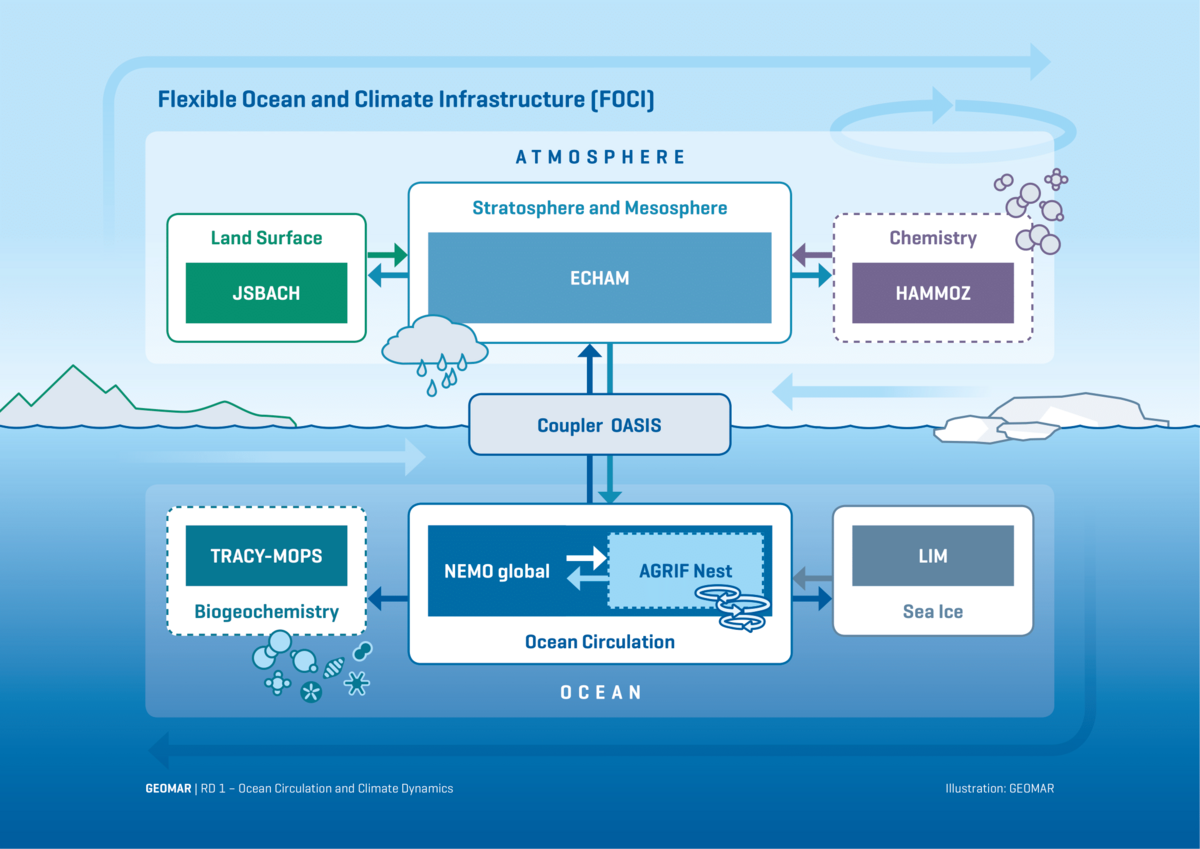The Flexible Ocean and Climate Infrastructure (FOCI)
In RD1, a large effort has been taken during the last years to build a common modelling system to cover all aspects of climate modelling activities within RD1, and the Flexible Ocean and Climate Infrastructure has been developed. The overall goal is to provide a flexible (technical) infrastructure to accomodate all modelling activities within RD1 and beyond (e.g. biogeochemistry modelling in RD2). FOCI's scientific performance is documented in a recent publications in GMD (Matthes et al., 2020). FOCI is the successor of KCM (developed at GEOMAR more than 10 years ago) with updated model components and additional options that were not available in KCM.
The first version of FOCI consists in its default setup of a global high-top atmosphere (European Centre Hamburg general circulation model; ECHAM6.3), a land surface model (Jena Scheme for Biosphere Atmosphere Coupling in Hamburg; JSBACH), a ocean model (Nucleus for European Modelling of the Ocean v3.6; NEMO3.6) as well as sea-ice (Louvain-la-Neuve sea Ice Model version 2; LIM2) which are coupled through the OASIS3-MCT software package.
A unique feature of FOCI is the ability to crank up the resolution in the ocean regionally using NEMO's AGRIF feature. These so-called ocean nests have been implemented for e.g. the North Atlantic or parts of the Southern Ocean. All ocean nest configurations that have been used in RD1 in either forced ocean simulations or fully coupled ocean-atmosphere setups are described on a separate page. As indicated in the schematic above, an optional module to include biogeochemical processes in the ocean (MOPS) is available and actively used.
In addition to the standard version of ECHAM6, a version of ECHAM6 that allows for the interactive calculation of aerosols and/or chemical processes is available. This version referred to as ECHAM6-HAMMOZ (Schultz et al., 2018) and is used to study the ozone hole variability under present and future climate conditions. In the current setup, FOCI is mostly configured to run at a horizontal resolution of 1.8° with 95 vertical levels (T63L95). It allows the model realistially simulate important dynamical processes such as the quasi-biennial oscillation (QBO).
As the performance of ECHAM6 rapidly decreases if the horizontal resolution is higher than approximately 1° the climate version of ECMWF's operational forecast model, OpenIFS, has been implemented into FOCI. In contrast to ECHAM6, OpenIFS scales very well at very high model resolutions. This allows us to reduce the mismatch in resolution between the high-resolution regional ocean nests and the rather coarse horizontal resolution of ECHAM6 in the atmosphere.
FOCI development
As part of ongoing research projects, FOCI development work currently focuses on:
- Development of new ocean nests covering e.g. the entire Southern Ocean or the entire Atlantik as part of ongoing research projects.
- Improve the biogeochemistry module in FOCI by including additional biogechemical processes.
- Fully integrate FOCI into the ESM-Tools runtime environment. ESM-Tools are a collection of Python3 tools, that handles the preparation, execution and postprocessing of a model simulation and are jointly developed at AWI (project lead), GEOMAR and other research institutes.
Publications:
The following publications document the current state of the FOCI modeling system
Matthes, K., Biastoch, A., Wahl, S., Harlaß, J., Martin, T., Brücher, T., Drews, A., Ehlert, D., Getzlaff, K., Krüger, F., Rath, W., Scheinert, M., Schwarzkopf, F. U., Bayr, T., Schmidt, H., and Park, W.: The Flexible Ocean and Climate Infrastructure version 1 (FOCI1): mean state and variability, Geosci. Model Dev., 13, 2533–2568, doi.org/10.5194/gmd-13-2533-2020, 2020.
Chien, C.-T., Durgadoo, J. V., Ehlert, D., Frenger, I., Keller, D. P., Koeve, W., Kriest, I., Landolfi, A., Patara, L., Wahl, S., and Oschlies, A.: FOCI-MOPS v1 – integration of marine biogeochemistry within the Flexible Ocean and Climate Infrastructure version 1 (FOCI 1) Earth system model, Geosci. Model Dev., 15, 5987–6024, doi.org/10.5194/gmd-15-5987-2022, 2022



